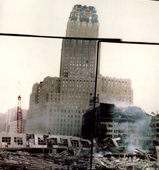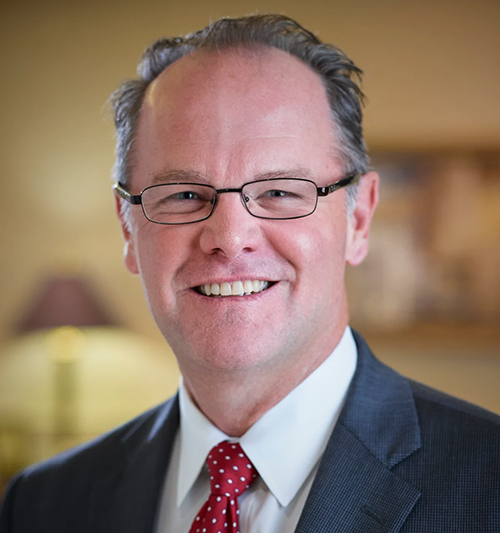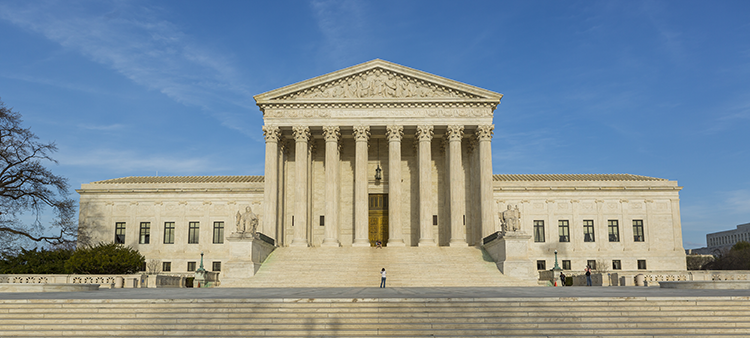Accounting for Lives

Photo by Pascal Perich.
Mari-Rae Sopper thought she was embarking on a new stage in her life when she boarded American Airlines Flight 77 the morning of Sept. 11, 2001, at Washington Dulles International Airport. Sopper had decided to leave behind her law practice in Washington, D.C., and return to gymnastics, the passion of her youth. After the flight reached Los Angeles, Sopper would go to her new job as head coach of the women’s gymnastics team at the University of California at Santa Barbara.
Sopper never made it to that new life. Instead, she and everyone else on Flight 77 died when terrorists took over the plane and crashed it into the Pentagon.
Sopper’s griefstruck parents wanted answers. Her mother, Marion Kminek of Cape Coral, Fla., says her initial inclination was to file a lawsuit in efforts to get them. But after consulting with two leading plaintiffs lawyers in Chicago, Kminek says, she decided to heed their advice that she avoid the frustration and delays of litigation and seek compensation, if not resolution, through the September 11th Victim Compensation Fund of 2001. Congress created the fund to handle claims by victims of the terrorist attacks as part of legislation providing relief to the airline industry.
Going through the fund didn’t give Kminek all the answers she was looking for, but it did give her some measure of closure through a relatively simple administrative process that resulted in a compensation payment after a relatively short time. But after going through the process, Kminek knows she will never get the information she really wanted about the events that led to her daughter’s death, and she wonders what would have happened if victims and their families had banded together and sued the airlines and government bodies.
“The lawsuits serve a purpose in that you don’t get changes made or the discovery done without them,” Kminek says. “Look at the tobacco lawsuits. If that was not done, I don’t think a lot of that information would be out there. None of us were doing this for the money. We were doing it for the discovery. But none of us will get the answers.”
UNCERTAIN VALUE
The mixed feelings Kminek expresses about the victim compensation fund are typical. Many legal experts who observed its workings, as well as victims and families of victims who filed claims with the fund, view it as a workable response to the unique disaster of Sept. 11. But they question how much value it might have as a model for future efforts to process large numbers of claims coming out of a single event.
Under the circumstances, the fund fulfilled its mission, says Kenneth R. Feinberg, who served as special master from the fund’s planning stages through the end of its work. He is the founder of the Feinberg Group, a Washington, D.C., law firm that concentrates on negotiated resolutions of complex legal disputes.
“For all the criticism, I think it was the right thing to do,” says Feinberg, who is now administering distribution of the Hokie Spirit Memorial Fund to victims of the shootings at Virginia Tech University in April. “The American people wanted it done, and to this day I think the American people think it was the right thing to do.”
In the wake of the Sept. 11 terrorist attacks, the airline industry, which was on shaky financial ground even before the attacks, was reeling. Meanwhile, survivors and their families wanted to identify and punish those within the system who had been responsible for the security of the four airliners hijacked that day, using that distinctly American form of justice known as tort law. And Congress, worried about further disruption to the country, quickly enacted legislation aimed at trying to ease the pain of both victims and the airline industry.
Less than two weeks after New York and Washington were attacked, President Bush signed into law the Air Transportation Safety and Stabilization Act, 49 U.S.C.A. § 40101. The law capped the liability of airlines and other related industries, and it assigned exclusive jurisdiction over lawsuits arising out of the attacks to the U.S. District Court for the Southern District of Manhattan. But the legislation also authorized the victim compensation fund to indemnify victims and their families in exchange for their waiver of all state and federal tort claims against the airlines and other possible tortfeasors related to the Sept. 11 attacks.
In 33 months, the fund completed its work, having processed the claims of 97 percent of all victims and families and paying out some $7 billion to survivors and the families of those killed in the attacks.
By December 2003, the final deadline for claims, the fund had received 2,880 out of 2,973 possible death claims and more than 2,600 injury claims. Average awards exceeded $2 million to families of those killed, while the awards to those injured amounted to nearly $400,000, according to the final report by Feinberg.
“To the extent that participation is a measure of success, the fund was extraordinarily successful,” Feinberg wrote in his report, issued in November 2004. According to the report, several factors contributed to this high participation rate, including the existence of the fund as an alternative to slow and costly litigation, the availability of detailed information about the likelihood of recovery from the fund, and the fund’s proactive approach to dealing with victims and surviving family members.
TORT TWISTER

Ground Zero
But, despite the speed and efficiency with which the fund operated, it is not without critics. Much of the criticism is aimed at its unique hybrid model of tort and no-fault liability that, among other issues, resulted in higher-wage earners receiving larger payouts than low-wage earners, awards being offset by collateral sources, and a lack of accountability for any possible wrongdoer or negligent party.
The fund has been both hailed as a model for tort reform and dismissed as a one-shot deal hastily established to deal with an unexpected situation. In addition, the fund has raised long-simmering issues about socioeconomic distinctions embedded in our system and whether government should be involved at all in compensating victims of terrorist acts, mass torts and natural disasters.
The United States long has had a love-hate relationship with its particular brand of tort law, which strives to serve the dual purposes of compensating victims and changing the behavior of alleged wrongdoers. American law also has a long history of administrative pre-emption of tort claims—the principle on which the Sept. 11 fund is based—that predates even the introduction of systems like workers’ compensation and Social Security disability.
According to Stanford University law professor Michele Landis Dauber, the federal government has been compensating the victims of various calamities, including what we now call terrorism, since the earliest days of the republic. In her research, she has found congressionally appropriated relief dating back to the Whiskey Rebellion of 1794. Like the Sept. 11 fund, those historical relief appropriations were often distributed through a centralized compensation bureaucracy headed by a commissioner “with broad discretion to evaluate applications, take evidence, and distribute benefits according to statutory eligibility criteria,” Dauber writes in a Winter 2003 DePaul Law Review article,“The War of 1812, September 11th, and the Politics of Compensation.”
In the case of the Sept. 11 fund, the authorizing legislation required the appointment of a special master to not only administer the fund but also create rules and procedures for its operation.
Feinberg was appointed Nov. 26, 2001. Among his responsibilities was determining how compensation would be calculated based on factors such as the economic and noneconomic harm suffered, and individual facts and circumstances.
Feinberg said in his report that he and his staff of lawyers, economists and others created actuarial tables similar to those used by insurance companies to determine the value of each claim. The tables considered age, number of dependents, earned income level at the time of death and similar factors.
To be eligible for a payout from the fund, claimants—including certain rescuers—needed to demonstrate that their damages occurred as a direct result of the attacks. Proof of the source of their injuries, Feinberg wrote, made them eligible for a base amount of compensation. The estate of a decedent with a spouse or a dependent, for example, would receive a minimum of $500,000, and the estate of a single decedent with no dependents would receive at least $300,000.
Applicants to the fund also were required to supply evidence of the victim’s personal characteristics, such as age and earning capacity. In the case of injured victims, reduced earning capacity and life expectancy were taken into account, along with lifetime medical care and similar tort issues. Awards then were offset by collateral sources such as life insurance and pension benefits.
The entire process was designed to be nonadversarial and efficient “to assure a prompt determination of awards” and “minimize the burden of claimants,” according to Feinberg’s report. “The presumed methodology was designed to provide generous awards to the families and to be simple to administer,” stated the report.“Claimants did not need to present detailed computations or analyses. Instead, they needed only to supply the fund with easily obtained data.”
Still, a small number of victims and their families chose to opt out of the fund and litigate their claims. According to news reports, about 60 lawsuits continue to wend their way through the courts. Most have been bogged down by the federal government’s refusal to release certain materials and other procedural hurdles, though a few have settled for undisclosed amounts.
Advocates of the fund’s administrative model say the problems litigants have encountered help show how the fund served its purpose and could be a model for other mass tort claims. But others wonder whether it is fair to compare the speed and efficiency of the fund and its payouts to the outcome of litigation.
ONE OF A KIND
The most prevalent view of the fund among experts is that it was a one-shot remedy applied to a unique disaster, says Edward F. Sherman, a law professor at Tulane University who was 2001-2003 chair of the ABA Task Force on Class Action Legislation. He sees the administrative scheme of the fund itself as a good model because of the efficiency with which it operated and awarded compensation. And much of the credit for that efficiency goes to Feinberg, Sherman and others agree, because Congress gave him significant autonomy over the fund’s operations.
“This was such an idiosyncratic fund in the way that it was administered that I am not sure you could duplicate it” for other torts, says James R. Copland, director of the Center for Legal Policy at the Manhattan Institute.
Copland, who wrote about the implications of the fund for future litigation and tort reform in a Manhattan Institute white paper, Tragic Solutions: The 9/11 Victim Compensation Fund, Historical Antecedents and Lessons for Tort Reform, says the fund needs to be put in its proper context. “It was created as part of a larger goal of making sure that the airlines continued to fly after Sept. 11.”
As such, Feinberg had almost none of the problems typically seen with a large class of plaintiffs in a mass tort, such as questions of causation. “You didn’t run into the sort of problems you’ve seen with the asbestos bankruptcy trust or the fen-phen litigation, where there were a lot of shenanigans about who were the actual victims and were they actually injured,” he says.
In addition, the degree of freedom Feinberg had in administering the fund is something that could not be replicated in other mass tort circumstances, Copland says, because there could not be an opt-out system to make it effective—as is done, for example, in most state workers’ compensation systems.
“Generally you want checks and balances, but here the notion was to give Feinberg a level of autonomy to do this, realizing of course that the families could opt out,” Copland says. “When you don’t have the option of opting out—which is a check on abuse—it is much more difficult.”
However, he notes, the fund functioned very efficiently when compared to the tort system. “Almost $7 billion was paid out,” he says. “It was an expensive cost to the taxpayer, but you certainly could argue that relative to the transportation infrastructure system the risk was not all that big.”
Copland believes the generous size of the awards was another reason so many victims opted in. While studies show that average jury verdicts may be larger, it takes longer to get the money and there’s more risk. “Here you could get the money quickly, so when you factor in the time and risk elements, it worked pretty well.”
But that same generosity might make this model unfeasible for other, larger mass torts. “When you have less than 3,000 people killed and an average payout of $2 million, that is not a lot of money. But if you have more people killed, then you start talking about too much money and you cannot replicate it,” Copland says.
Stanford law professor Robert Rabin says Feinberg got the fund to do what it was set up to do, in spite of its structure. He says that Congress was confused when it created the hybrid of tort and no-fault principles in the fund, and that a more traditional no-fault model would have been more appropriate. The scheme could take into account economic loss, but he says it should provide greater horizontal equity by capping awards.
“I am not convinced, however, that it makes sense to sort out victims of terrorism as a special category versus victims of other misfortunes,” he says. Dauber says the fund will serve as precedent should there be another terrorist attack, but it should not serve as a model. Like Rabin, she takes issue with the tort-based compensation system that valued some victims over others, depending on their earnings.
“It’s a terrible idea for the government to treat some citizens as more worthy than others,” she says. “While this works with a specific tortfeasor who is at fault, it’s a bad idea for government welfare-type compensation.”
For many of the victims and their families, however, the fund fell short in one very important area: accountability.
Mary Schiavo represents the bulk of the plaintiffs who opted out of the fund to pursue litigation. She says her clients chose to sue, in large measure, because the fund offered no opportunity for discovery and, hence, no opportunity to place blame. Schiavo, a lawyer at Motley Rice in Mount Pleasant, S.C., says her clients are adamant that the airlines, security companies and airplane manufacturers bear some public responsibility for the deaths and injuries in the Sept. 11 attacks. Aircraft manufacturer Boeing is being sued, for instance, because its design allowed the Sept. 11 hijackers easy access to the planes’ cockpits.
Schiavo firmly believes that the tort system—and not administrative pre-emption—is the best way to handle disasters like 9/11. “These folks we represent were not victims of terrorism. They are the victims of the airlines’ negligence,” she says.
FAMILIES’ FEELINGS
Similarly, the nonprofit group calling itself the Families of September 11 says that lack of a mechanism to expose the negligence that led up to the terrorist attacks is a primary reason that the group has a mixed response to the fund.
Donald W. Goodrich, a partner at Donovan and O’Connor in North Adams, Mass., who chairs the group, says the fund was an afterthought. “To say it should be a model is a grave error in judgment.”
Though Goodrich applauds Feinberg for all his hard work and the speed with which he and his staff administered the fund, his group finds fault with the overall mission. While the fund did allow those families who opted in to be compensated quickly and go forward with their lives, it failed to apportion fault, create accountability and, ultimately, have a deterrent effect, he says.
The fund has some lesser flaws too, Goodrich says: the failure to cap lawyers’ fees and the use of collateral sources to offset awards to victims. “People who protected for their future should not have been penalized,” he says. Moreover, its use of age in assessing noneconomic damages devalued the lives of older victims.
“The tort system provides a truth-seeking mechanism—a tribunal where, through the process of evidence, the trying of fact can take place in a setting that has proven effective for centuries. That does not exist in the victim compensation fund. It is just a paper-driven process,” says Goodrich, whose son Peter died that day on United Airlines Flight 175.
“In order for there to be true deterrence, we have to find out the true causes. We can’t bury it in paper. There has to be true responsibility,” Goodrich adds. Those taking the most risk should bear responsibility through higher insurance premiums, he says. “We expect higher premiums where risk and exposure are greater. Increased premiums are the incentive to decrease risk and exposure,” Goodrich says. “None of those concepts are embedded in a system like the victim compensation fund.”
He remains most troubled, however, by the failure of the government to address how to respond to future terrorist attacks. Goodrich is a proponent of the Terrorism Risk Insurance Act, which is up for renewal in Congress. The act would provide ongoing federal support for private terrorism risk insurance. “If there is a future terrorist act,” he says, “those responsible [for losses] will have insurance and be backed up by the federal government.”
Correction
A sentence in “Accounting for Lives,” September 2007, incorrectly suggests that Donald W. Goodrich, chair of Families of September 11, holds the view that single-sum payments for noneconomic damages by the September 11 Victim Compensation Fund devalued the lives of older victims. In fact, Goodrich says the fund’s formula undervalued the lives of younger victims.The Journal regrets the error.



